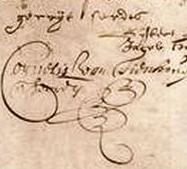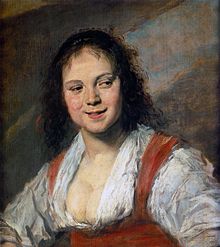The Fulkerson Family Pages
Cornelis Van Tienhoven: Scoundrel
The Vigne's had three daughters when they arrived in New Netherlands in 1624. The youngest, Rachel, was just 16 when she had the misfortune to marry Cornelis Van Tienhoven. The event was succinctly characterized by the receipt it produced:
Cornelis van Tienhoven . . . in my capacity as husband and guardian of Ragel Vienje, . . . acknowledge that I am fully satisfied and paid by Jan Jansen Damen the sum of once three hundred Carolus guilders to which the aforesaid Ragel Vienjee . . . was entitled by way of inheritance from her father Gulyn Vienjee, according to the contract made between her mother Adriaenje Cuveljeers and Jan Damen.
Cornelis Van Tienhoven arrived in New Amsterdam in 1633 as a Company accountant, working for Director Wooter Van Twiller until the latter's removal in 1638.
With the arrival of Director Willem Kieft, Van Tienhoven was promoted to the title of Secretary and in many instances served as the Director's "right hand man. "
After Kieft's removal in 1647, Van Tienhoven continued as the Secretary to Peter Styvesant; then, in 1651, Van Tienhoven was promoted to "receiver general" of the Company's revenues and domains (New Netherland then included the area from Albany to Delaware).
In 1652 Stuyvesant made Van Tienhoven Schout-Fiscaal (sheriff and attorney general) of New Amsterdam.
Cornelis and his young family lived on a "plantation" at Smits Vly [Smith's Flat] on the East River shore, north of Wall Street. His land was on the northern edge of his in-laws' bouwerie, extending west from Broadway to the East River, and north from Maiden Lane to about Fulton Street. His address was about 227-229 Pearl Street, near where it intersects Maiden Lane. The current New York City street called Pine Street, in the Wall Street financial district, was known as Tienhoven Street during the 1600s.
At first glance, it would seem that Cornelis was a propertied, well-established pillar of the community--he was considered to be intelligent, subtle and sharp-witted. The population of New Amsterdam knew him better, though, as a "thickset" man with a "red and bloated" face who was "given to lying, promising everyone. " One wrote, "the whole country cries out against him bitterly as a villain, murderer and traitor. " He was, in fact, the perhaps the most atrocious character in the history of Manhattan, bar none.
Cornelis Van Tienhoven Cornelis was known as a womanizer. Gossips relayed the news of his dressing as an Indian "with a little covering" and chasing after the many "light women" of New Amsterdam.
In 1649, on a lengthy trip back to Holland to offer his explanation why the colony was not progressing, Van Tienhoven (who had been married to Rachel, aged 26, for ten years) "became engaged" to a young lady. The unsuspecting girl accompanied him on his travels in Holland and on the two-month voyage back to America, expecting to marry him at the end of the journey. When their ship, the Waterhont, tied up at New Amsterdam, Van Tienhoven suddenly became a family man again, since wife Rachel was awaiting him at the dock.
Such was Van Tienhoven's influence among the corrupt officials in the colony, no one would listen to the poor girl's tale of betrayal. Sadly, we do not know her name, or whether she remained in New Netherlands or returned home.
Spring 1640, some parties of Raritan Indians attacked a Company trading boat near Staten Island and stole a canoe--they were also accused of stealing some swine. [The pigs were actually stolen by some sailors who blamed the Indians for the theft. ]
In mid-July, Director Kieft sent Van Tienhoven on an expedition (with 50 soldiers and 20 sailors) to confront the Raritans. Their orders were to force a peace, or, failing that, to take prisoners and destroy the Raritans' corn crop. On his arrival at their village, the Raritans refused Van Tienhoven's demand for restitution of the alleged losses.
Signature of Cornelius Van Tienhoven
Frans Hals' tronie, with the later title Gypsy Girl, 1628–30, may give us a glimpse of one like the young temptress who got more than she bargained for in her New Netherlands-bound voyage with Cornelis Van Tienhoven.


